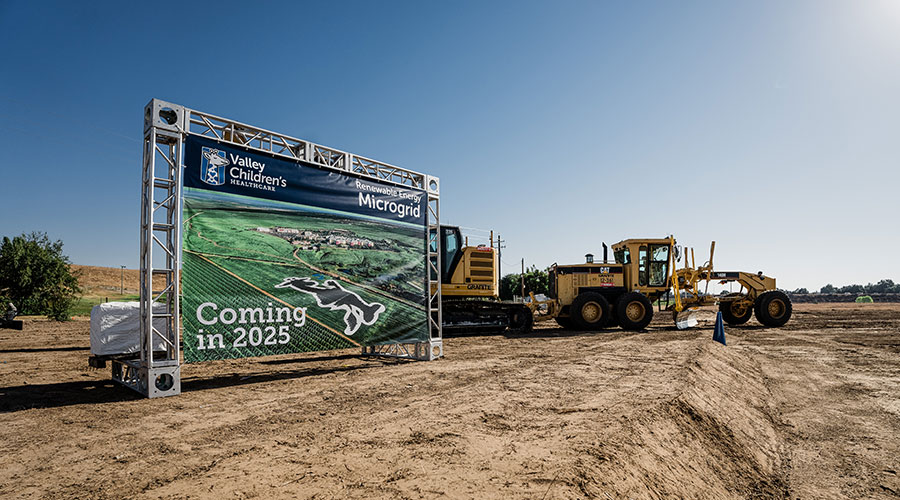As concerns around climate change continue to grow, so have conversations about addressing those concerns with actionable plans. Healthcare facilities use vast amounts of energy to provide around-the-clock care. As a result, healthcare facilities managers are looking for ways to cut their facilities’ emissions and operate more sustainably.
Resilience — being able to bounce back from crises quickly and effectively — is a critical part of sustainability. With the changes to climate and weather becoming more extreme, healthcare facilities must brace themselves for emergencies and ensure they can rebound from them.
California, which has seen its share of disastrous wildfires in recent years, is home to many different healthcare organizations and facilities that can be affected by wildfire. The worst-case scenario is that these vital pieces of infrastructure are rendered powerless or shut down because of wildfires.
Being proactive, Valley Children’s Healthcare in Madera, California, initiated a project to install a microgrid on its campus to not only help reduce its emissions, but to give it a lifeline in case of an emergency, such as a wildfire.
Justifying a microgrid
The justification for the microgrid project was three-fold, says Ratan Milevoj, the organization’s vice president of innovation and assistant chief strategy officer. The organization undertook the project to address the threat of wildfires, as well as its aging infrastructure.
“We’re connected to a single substation from which we get our power services, and that substation is about halfway through its life and requires some significant maintenance,” Milevoj says. “Again, that vulnerability from a resilience perspective was a key part of the strategy.”
The project’s third component involved the rising costs of labor and supplies. Milevoj says organizations can contain very few of these costs, except for energy to a degree.
“So the reason we started to think of this microgrid as a strategy is because the cost of energy is also continuing to rise,” she says. “In our pro forma that we did, we wanted to understand what the cost would be if we put in our own microgrid — which means in essence we are creating our own energy — versus the energy cost as it's rising.”
The organization’s estimates were based on a conservative assumption that the cost of energy will increase 3-4 percent per year. But Milevoj says this cost can fluctuate due to external factors, such as war and supply chain issues.
“There are a lot of things that are out of our control,” she says.
Given these circumstances, Valley Children’s Healthcare chose a microgrid to address these issues. How did the microgrid project ultimately come together?
The technology behind the microgrid
Milevoj says the organization went through many different methods for generating and storing energy including fuel cells, on- and off-site solar, waste conversion and cogeneration.
While solar is a relatively inexpensive source of renewable energy, Milevoj says the organization did not have enough space for a solar field large enough to power their facilities. Also, even though the location gets plenty of sunlight during the day to generate power, it would not be able to do so at night.
Eventually, the organization turned to fuel cells. Milevoj says fuel cells do not require as much space as solar, they produce quite a bit of energy, and they are scalable. For these reasons, more fuel cells can be added in time.
The challenge with fuel cells is that they generate energy at a constant level, meaning that energy would need to be stored somehow. Given this requirement, the organization opted to store the generated energy in batteries.
“Really, the combination of fuel cells, batteries and solar was the right combination for our microgrid,” Milevoj says.
The benefits
After factoring in depreciation and costs, Milevoj says the organization found that the microgrid would provide operational savings. According to Valley Children’s Healthcare’s pro forma, the microgrid is projected to provide a minimum of $15 million in savings in energy costs over 25 years.
The microgrid also is set to reduce the organization’s greenhouse gas emissions by more than 50 percent by 2030, further aiding its goal to achieve net-zero emissions by 2050. It will also allow the organization to stay operational in case of power outages, since it will not have to rely as much on traditional power grids.
The microgrid project broke ground in September 2024 and is set to begin operating in 2025.
Jeff Wardon, Jr., is the assistant editor for the facilities market.

 The Rising Strategic Value of Owner's Reps in Healthcare
The Rising Strategic Value of Owner's Reps in Healthcare Lawrence Group Designs Pair of Ignite Medical Resorts in Missouri
Lawrence Group Designs Pair of Ignite Medical Resorts in Missouri Construction Complete for Centra Langhorne Medical Center
Construction Complete for Centra Langhorne Medical Center Making the Energy Efficiency Case to the C-Suite
Making the Energy Efficiency Case to the C-Suite How to Avoid HAIs This Flu Season
How to Avoid HAIs This Flu Season